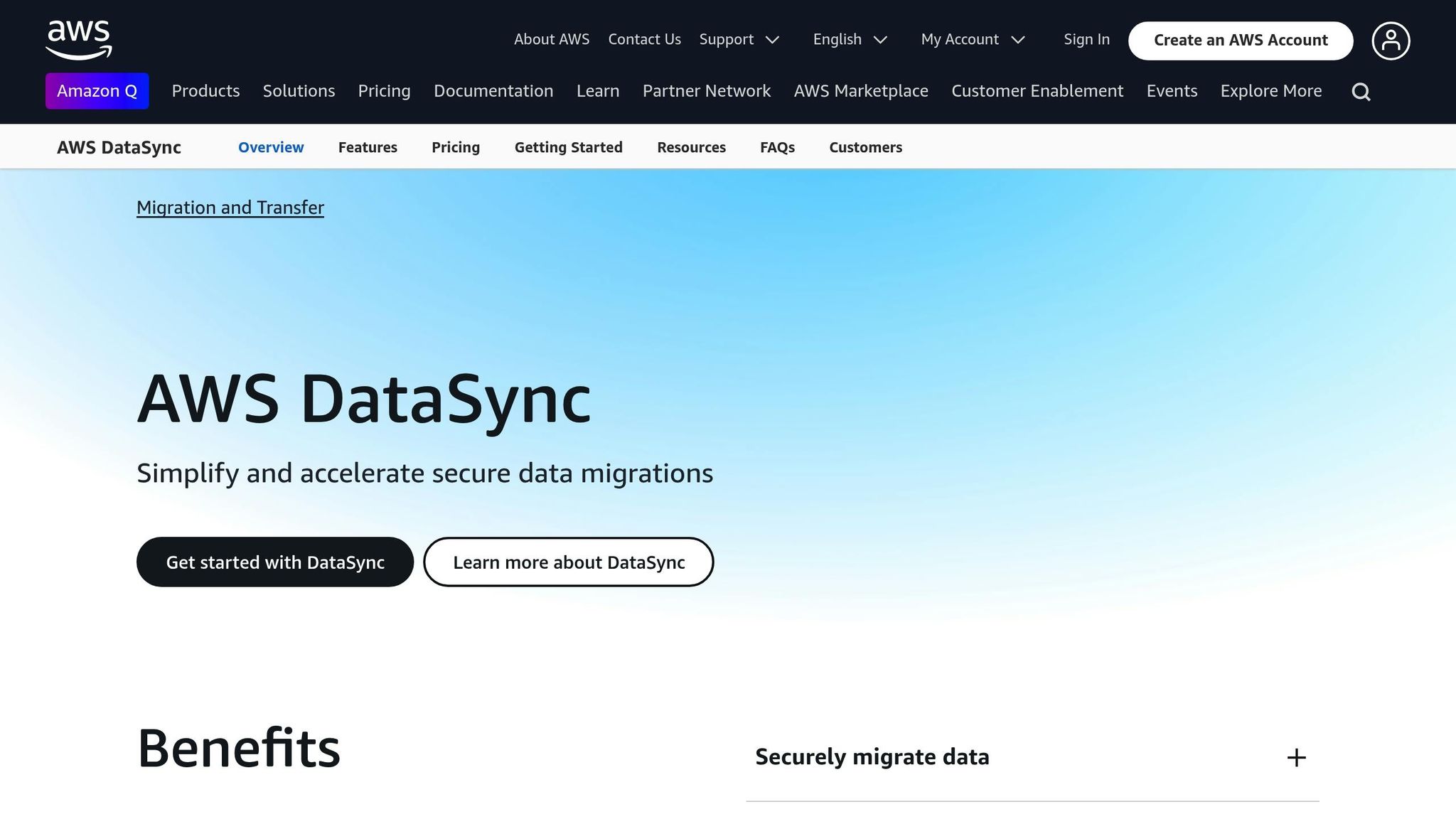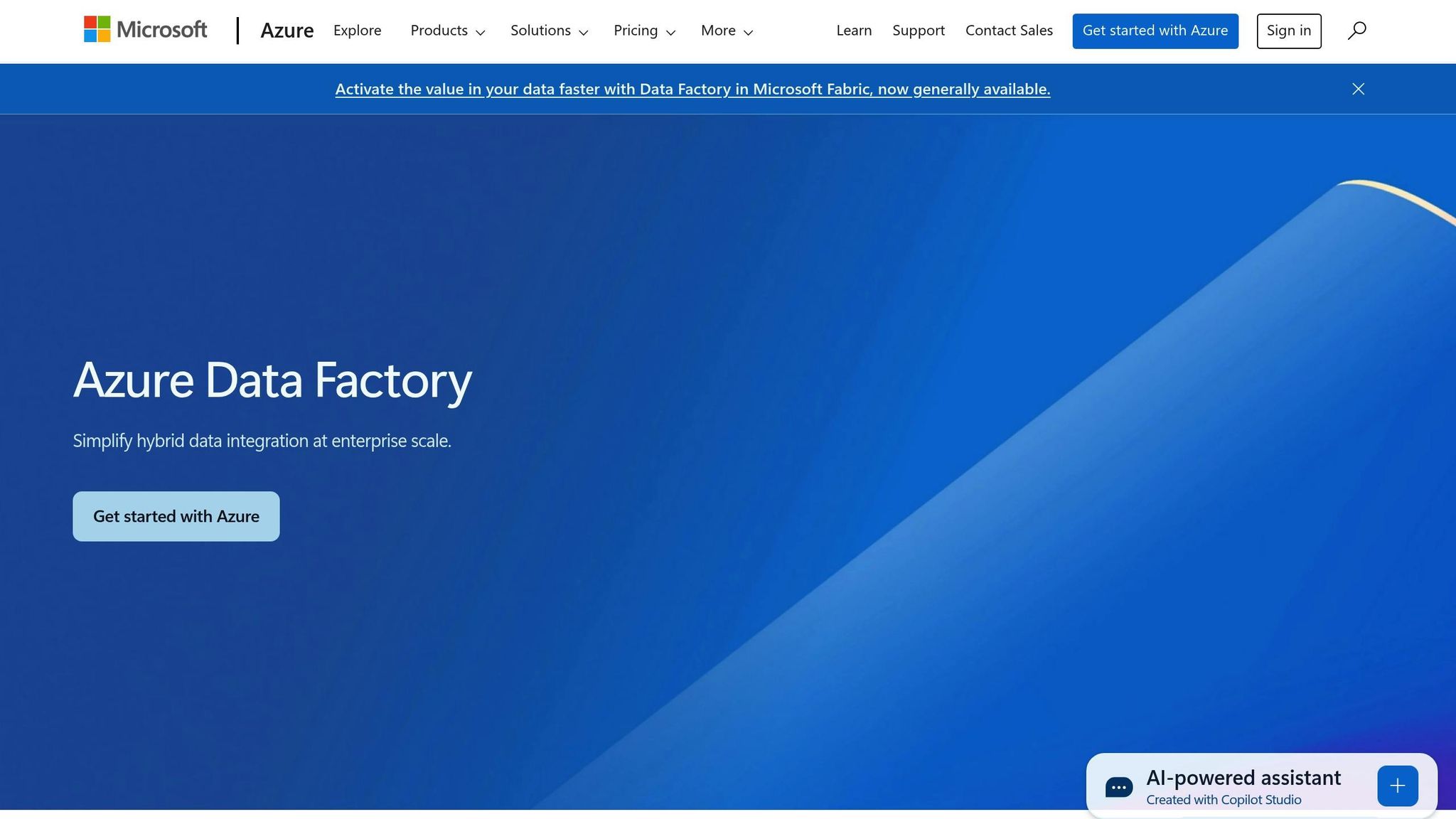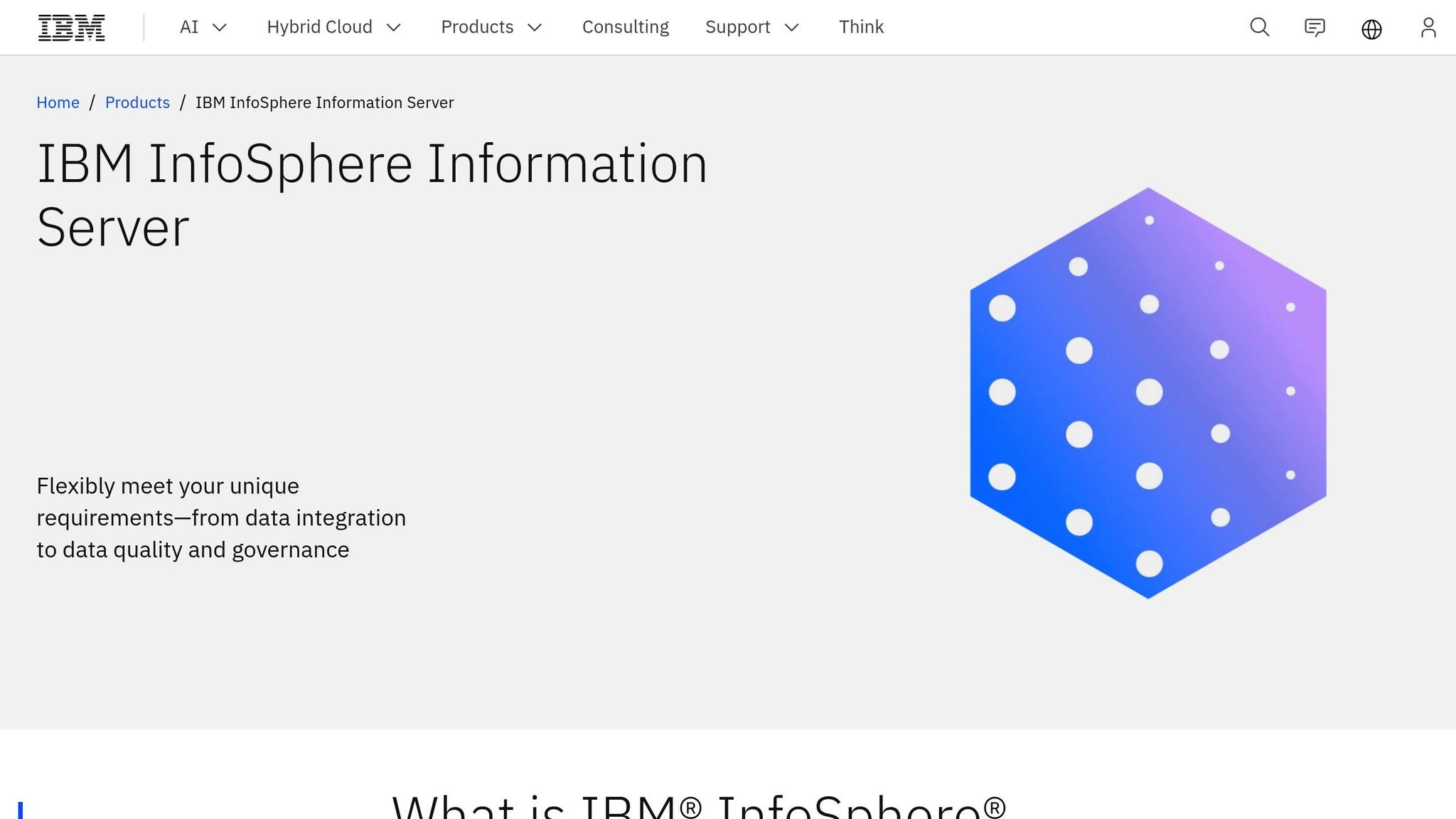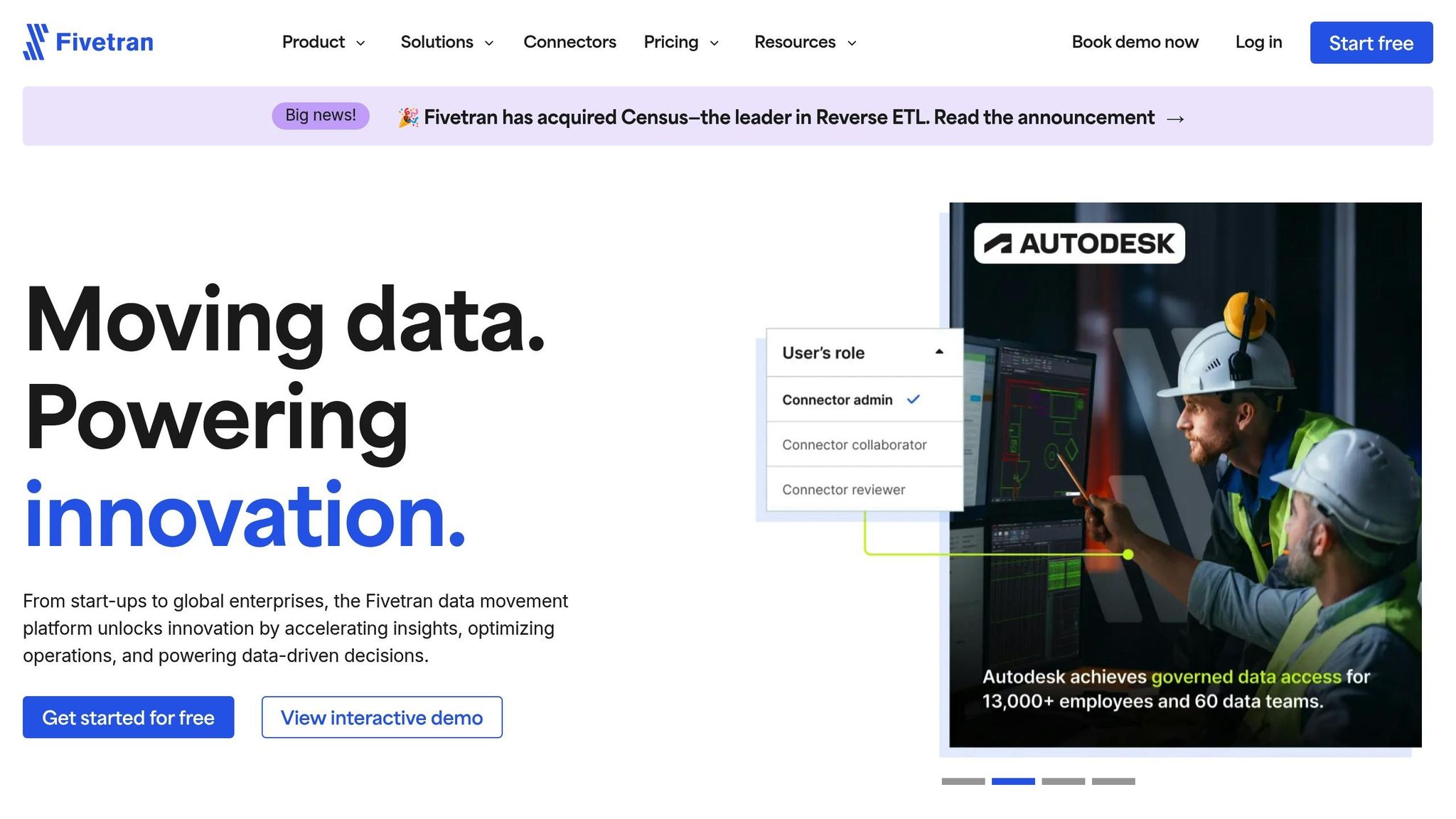The hybrid cloud world in 2025 presents unique challenges for UK organisations, including strict data residency laws, GDPR compliance, and the need to manage cloud costs efficiently. To address these, businesses are increasingly using hybrid cloud data synchronisation tools to transfer data securely between on-premises and cloud systems. Here's a quick overview of the top tools tailored to UK-specific needs:
- AWS DataSync: Ideal for large-scale batch transfers. Offers secure connections via AWS Direct Connect and PrivateLink, with transparent pay-as-you-go pricing (£0.01 per GB).
- Azure Data Factory: Flexible for real-time and batch processes. Features UK data residency options and advanced compliance tools. Costs start at £0.80 per 1,000 pipeline runs.
- Google Datastream: Focused on real-time streaming with low latency. Pricing is usage-based, with free migrations for same-engine databases.
- IBM InfoSphere: Combines real-time replication and batch processing, designed for enterprise-grade data consistency. Licence-based pricing.
- Fivetran: Uses a Local Data Processing Agent for secure, incremental updates. Pricing is based on monthly active rows.
Each tool caters to different needs, from compliance to cost control, making it vital to choose based on your organisation's specific requirements.
Quick Comparison
| Tool | Sync Style | Compliance Features | Pricing Model | Best For |
|---|---|---|---|---|
| AWS DataSync | Batch transfers | UK/EU data residency, TLS, KMS | Pay-per-GB (£0.01/GB) | Large-scale batch transfers |
| Azure Data Factory | Real-time and batch processing | UK South/West data residency | Pay-per-pipeline (£0.80/run) | Flexible sync schedules and compliance needs |
| Google Datastream | Real-time streaming | UK GDPR, TLS 1.3 | Usage-based | Real-time low-latency streaming |
| IBM InfoSphere | Real-time and batch | End-to-end encryption, GDPR | Licence-based | Enterprise-grade reliability and consistency |
| Fivetran | Incremental updates | UK-based regions, AES-256 | Monthly active rows | Secure and efficient hybrid sync |
These tools provide a foundation for modernising data management strategies while balancing compliance, cost, and operational efficiency.
What's New in Hybrid Cloud, Edge Computing, and Data Transfer
1. AWS DataSync

AWS DataSync is a service designed to transfer data between on-premises storage and the AWS cloud. It's particularly useful for large-scale migrations or periodic synchronisation in hybrid setups across the UK.
Hybrid Connectivity Options
DataSync connects on-premises infrastructure to AWS using a virtual-machine agent. This connection can be established securely via the internet, AWS Direct Connect, or VPN, and supports simultaneous data transfers for efficiency.
For organisations in the UK with heightened security requirements, DataSync can integrate with AWS PrivateLink, ensuring that data does not pass through the public internet. The service supports a variety of source systems, including Network File System (NFS), Server Message Block (SMB), and object storage, which simplifies integration with existing setups.
Data Synchronisation Type
DataSync is designed for batch, scheduled, or on-demand transfers rather than real-time streaming. It uses incremental transfers to optimise bandwidth and includes built-in checksums to verify data integrity during the process.
Security and Compliance
AWS DataSync adheres to UK and EU regulations by encrypting data in transit with TLS and securing it at rest with AWS Key Management Service (KMS).
The service generates detailed transfer logs and integrates with AWS CloudTrail, providing a comprehensive audit trail. UK organisations can monitor data movements to meet compliance requirements, with logs detailing timestamps, file paths, and transfer statuses.
Additionally, DataSync supports AWS data residency controls, allowing UK businesses to select specific AWS regions for handling their data. This feature helps meet localisation requirements while maintaining operational flexibility.
Pricing Transparency and Suitability for UK Enterprises
AWS DataSync uses a pay-as-you-go pricing model based on the volume of data transferred. As of 2025, the cost is $0.0125 per GB for data moved into or out of AWS, with no upfront fees or minimum commitments. This transparent pricing allows UK organisations to manage synchronisation costs effectively.
For example, transferring 10 TB of data per month would cost approximately $125 (around £100), making it a cost-efficient choice for businesses with varying data transfer needs. This approach eliminates the need for significant investment in dedicated infrastructure, as users only pay for what they use.
UK enterprises benefit further from DataSync's integration with AWS Cost Explorer and budgeting tools, which provide detailed cost analyses and spending forecasts. These features are especially helpful for organisations managing strict cloud budgets.
With its flexible pricing and robust features, DataSync proves to be a valuable addition to the hybrid cloud strategies of UK businesses.
2. Azure Data Factory with Integration Runtime

Following AWS DataSync, Microsoft's Azure Data Factory (ADF) offers another robust solution for hybrid connectivity. ADF is a cloud-based platform designed to facilitate the movement of data between on-premises systems and Azure cloud services. At the heart of this setup is the Integration Runtime - a key component that ensures secure hybrid connectivity for UK organisations handling diverse data environments.
Hybrid Connectivity Options
The Self-hosted Integration Runtime is the backbone of Azure Data Factory's hybrid cloud data synchronisation. By installing it on on-premises or virtual machines, businesses can securely connect to Azure without the need to modify firewall rules.
For enhanced reliability, UK organisations can deploy multiple self-hosted integration runtime nodes across various locations, ensuring high availability and efficient load distribution. The service also supports Azure ExpressRoute, which provides dedicated private connections - a critical feature for organisations with strict data governance requirements or those managing large-scale data transfers.
Additionally, ADF integrates with Azure Private Link, enabling data to travel exclusively over Microsoft's private network. This setup is particularly appealing to sectors like financial services and healthcare in the UK, where compliance with stringent data protection laws is essential.
For those seeking a more hands-off approach, ADF offers a managed virtual network integration runtime. This serverless option securely bridges private endpoints without requiring on-premises maintenance, simplifying operations even further.
Data Synchronisation Options
Azure Data Factory supports a variety of synchronisation methods, including batch processing, scheduled transfers, and change data capture (CDC) for near real-time updates.
The mapping data flows feature allows for complex data transformations during synchronisation. This means UK businesses can cleanse, restructure, and aggregate data as it moves between systems - ideal for consolidating legacy system data into modern cloud-based data warehouses.
For time-sensitive operations, ADF provides tumbling window triggers, which can execute pipelines as often as every 15 minutes. While this isn't true real-time streaming, it offers near real-time synchronisation that meets the needs of most business scenarios.
Security and Compliance
Azure Data Factory is designed with security and compliance in mind, aligning with UK and EU standards. All data transfers are encrypted using TLS 1.2, and integration with Azure Key Vault ensures secure management of encryption keys and connection strings.
For UK organisations, Azure supports data residency requirements by offering processing and storage within the UK South and UK West regions. This capability helps businesses comply with GDPR and other industry-specific regulations.
To support operational monitoring and compliance reporting, Azure Monitor and Log Analytics provide detailed audit trails. These logs capture pipeline execution details, data lineage, and performance metrics, offering full visibility into data movement activities.
Role-based access control (RBAC) integrates seamlessly with Azure Active Directory, allowing organisations to assign granular permissions based on existing identity systems. This simplifies user management while maintaining strong security protocols.
Pricing Transparency and Suitability for UK Enterprises
Azure Data Factory employs a consumption-based pricing model with separate charges for orchestration, data movement, and data flows. As of 2025, pipeline orchestration costs £0.80 per 1,000 runs, while data movement is billed at £0.20 per Data Integration Unit (DIU) hour.
For a typical UK business handling moderate data volumes - such as 500 pipeline executions and 100 hours of data movement - the monthly cost is estimated at around £140. This transparent pricing model helps organisations predict expenses based on usage patterns.
The pay-as-you-go approach is particularly advantageous for businesses with fluctuating data synchronisation needs, as it eliminates upfront infrastructure costs and long-term commitments. Azure's cost management tools further enhance budgeting by providing a detailed breakdown of expenses.
For organisations already invested in the Microsoft ecosystem, the Azure Hybrid Benefit can reduce costs even further. By leveraging existing Microsoft licences, businesses can lower expenses, making Azure Data Factory a cost-effective option for data integration and synchronisation.
3. Google Datastream and Database Migration Service

Google’s approach to hybrid cloud data synchronisation combines two key services: Google Datastream for real-time data capture and Database Migration Service (DMS) for full-scale database transfers. Together, these services give UK organisations flexible tools for both continuous synchronisation and one-off migrations between on-premises systems and the Google Cloud Platform.
When it comes to pricing, Google keeps things straightforward. Database Migration Service supports migrations within the same database engine - for instance, moving from on-premises MySQL to Cloud SQL - at no extra cost. For migrations between different database engines, pricing depends on factors like data volume, migration method, and regional considerations.
For ongoing synchronisation, Google Datastream operates on a tiered, usage-based pricing model based on data volume. However, additional costs may arise for compute, storage, or network egress. To help businesses estimate expenses, Google provides a pricing calculator, making it easier for UK enterprises to plan cost-effective migrations and synchronisation efforts.
Need help optimizing your cloud costs?
Get expert advice on how to reduce your cloud expenses without sacrificing performance.
4. IBM InfoSphere Data Replication and DataStage

IBM's InfoSphere suite is a key player in supporting hybrid cloud strategies in the UK. By combining real-time change data capture (CDC) with batch processing, it ensures data remains consistent and reliable across different environments. With its integration of Data Replication and DataStage, the solution meets the varied demands of data synchronisation in hybrid cloud setups. Here's a closer look at how these components handle both continuous updates and scheduled bulk transfers.
Data synchronisation type (batch, real-time, or change data capture)
InfoSphere CDC relies on log-based methods to track and capture only the changes made to data, whether destined for target databases, message queues, or ETL tools like DataStage [1][2][3]. At the same time, DataStage facilitates scheduled batch transfers, handling large volumes of data efficiently. Together, these tools provide a robust and secure way to maintain data consistency, a critical requirement for ensuring compliance and meeting performance expectations in the UK.
5. Fivetran with Local Data Processing Agent

Fivetran offers a standout solution for hybrid cloud synchronisation with its Local Data Processing Agent. This tool processes data locally before integrating it with cloud systems, making it ideal for organisations that need to balance scalable analytics with the requirement to keep sensitive data on-premises.
Hybrid Connectivity Options
The Local Data Processing Agent serves as a secure connector between on-premises systems and Fivetran's cloud service. It can link these environments using VPNs or private networks, ensuring data transfers happen within a controlled and secure framework.
For UK businesses navigating strict data governance rules, this setup provides greater control over how data moves. The agent can process and transform data locally, sending only the necessary information to cloud data warehouses. This not only reduces bandwidth demands but also supports compliance with local regulations. By acting as a secure link, the agent enables efficient, real-time synchronisation without compromising data control.
Data Synchronisation Methods
Fivetran employs incremental updates and change data capture to streamline data synchronisation. Instead of transferring entire datasets, the platform identifies and syncs only the records that have been modified. This approach significantly cuts down on processing time and minimises network usage.
The Local Data Processing Agent further enhances efficiency by applying transformation logic locally. By filtering and preparing data before transmission, it ensures that only the most relevant information is sent to the cloud, making synchronisation faster and more resource-efficient compared to cloud-only methods.
Security and Compliance
Security is at the heart of Fivetran's hybrid architecture. The Local Data Processing Agent encrypts all data using AES-256 protocols before transmission and maintains detailed audit logs to track data movements. These features align with UK GDPR requirements, offering businesses peace of mind.
For organisations concerned with data residency, the agent can be configured to use UK-based cloud regions. Fivetran supports integration with major providers like AWS London, Microsoft Azure UK South, and Google Cloud London, ensuring data sovereignty throughout the synchronisation process.
Pricing Transparency and Suitability for UK Enterprises
Fivetran's pricing for hybrid deployments is based on monthly active rows, providing a straightforward, usage-based model. This approach allows UK businesses to scale predictably and manage costs effectively - a critical consideration for enterprises operating in 2025's competitive landscape.
Tool Comparison Table
The table below outlines the key features of various tools, helping UK enterprises assess their suitability in terms of performance, compliance, and cost as of 2025.
| Feature | AWS DataSync | Azure Data Factory | Google Datastream | IBM InfoSphere | Fivetran |
|---|---|---|---|---|---|
| Sync Style | Batch transfers with scheduling | Real-time and batch processing | Real-time streaming with CDC | Real-time replication and batch | Incremental updates with CDC |
| Bi-directional Support | Limited (primarily one-way) | Full bi-directional sync | One-way streaming | Full bi-directional replication | Limited (primarily cloud-bound) |
| On-premises Connectors | DataSync agent required | Self-hosted Integration Runtime | Private connectivity via VPC | Built-in connectors | Local Data Processing Agent |
| Network Options | VPC endpoints, AWS Direct Connect | ExpressRoute, VPN Gateway | Private Google Access, VPN | Dedicated network connections | VPN, private networks |
| Conflict Handling | Basic file-level conflict detection | Custom conflict resolution rules | Source-based conflict resolution | Advanced conflict resolution algorithms | Automated conflict detection |
| Encryption & Compliance | AES-256, GDPR compliant | AES-256, UK GDPR certified | TLS 1.3, SOC 2 Type II | End-to-end encryption, GDPR | AES-256, detailed audit logs |
| Typical Latency | Minutes to hours (batch) | Near real-time (seconds) | Sub-second streaming | Real-time (milliseconds) | Minutes (incremental updates) |
| Pricing Model | Per GB transferred | Pay-per-use pipeline runs | Per stream and data volume | Licence-based with support | Monthly active rows |
| UK/EU Data Residency | AWS London region | Azure UK South/West | Google Cloud London | UK data centre options | UK-based cloud regions |
Key Takeaways on Performance, Cost, Compliance, and Security
The tools differ significantly when it comes to performance characteristics. AWS DataSync is well-suited for large-scale batch transfers but lacks real-time capabilities. Azure Data Factory offers flexibility with both real-time and batch processing, while Google Datastream excels in sub-second latency for streaming. IBM InfoSphere, on the other hand, stands out for its enterprise-grade reliability and advanced features.
When considering cost predictability, Fivetran's monthly active rows pricing model is particularly appealing for UK businesses, as it aligns costs with actual data usage. In contrast, AWS DataSync can become costly if transfers are frequent, while Azure's pay-per-pipeline approach works best for organisations with consistent sync schedules.
For compliance, IBM InfoSphere and Azure Data Factory lead the pack, offering comprehensive audit trails and strong data governance features. These tools are especially valuable for regulated sectors like finance, where meeting strict compliance standards is non-negotiable.
In terms of network security, IBM InfoSphere and Azure Data Factory offer robust private connectivity options, making them ideal for organisations with complex network requirements. AWS DataSync and Google Datastream provide good security features but may lack the same level of customisation for intricate architectures.
Ultimately, the best tool depends on your specific needs, such as latency requirements, data volume, compliance obligations, and integration with your existing cloud ecosystem. For organisations already committed to a particular cloud provider, native tools (AWS DataSync, Azure Data Factory, or Google Datastream) often provide smoother integration, enhancing overall workflow efficiency.
Conclusion
Selecting the right hybrid cloud data synchronisation tool comes down to factors like performance, cost, compliance needs, and your network setup. For batch transfers, AWS DataSync is a strong contender. If real-time updates are your priority, tools like Google Datastream or IBM InfoSphere excel. For a more balanced and flexible approach, Azure Data Factory is worth considering.
Cost and compliance are also key. Fivetran's pricing model, based on monthly active rows, ensures your costs align with actual usage. Meanwhile, Azure Data Factory's pay-per-pipeline structure is ideal for organisations with predictable sync schedules. For UK businesses operating in regulated fields such as healthcare or financial services, IBM InfoSphere and Azure Data Factory stand out with their robust audit trails and data governance features, fully compliant with UK GDPR regulations. Both tools also offer strong data residency options within the UK, making them particularly suitable for enterprises with strict localisation requirements.
Your current network architecture and cloud ecosystem also play a big role. Organisations already committed to a specific cloud provider often find native tools offer smoother integration and better support. This can simplify operations and reduce complexity.
For businesses with unique challenges, consulting experts can make all the difference. Firms like Hokstad Consulting specialise in crafting tailored hybrid cloud solutions. They provide strategic cloud migration advice and custom development services, helping UK businesses optimise their data synchronisation strategies. Notably, Hokstad Consulting has been known to cut cloud costs by 30-50% through their cost engineering expertise.
Ultimately, the tool you choose should not only meet your current needs but also scale with your organisation’s growth, addressing the challenges highlighted in these top hybrid cloud data sync solutions for 2025.
FAQs
How can I choose the best hybrid cloud data sync tool to meet my organisation's compliance and data residency requirements in the UK?
To choose the best hybrid cloud data sync tool for your organisation's compliance and data residency requirements in the UK, prioritise options that cater specifically to UK data sovereignty laws and offer strong data residency controls. The tool should comply with regulations like GDPR and include features such as data governance, audit trails, and the capability to store and process data within UK borders.
Select tools that simplify compliance by streamlining data residency management. Ensure they can meet your organisation's unique needs, whether that involves handling sensitive data or adhering to audit requirements. By focusing on these features, you can stay compliant with regulations while maintaining smooth and efficient hybrid cloud operations.
How do pricing models for hybrid cloud data sync tools differ, and what impact could they have on my organisation's budget?
Pricing models for hybrid cloud data synchronisation tools in 2025 come in various forms, each with a unique impact on your organisation's budget. Some providers follow a pay-as-you-go approach, where costs increase based on the amount of data you move. Others stick to flat-rate pricing, offering predictable costs regardless of usage. A growing trend is the use of hybrid models, which blend different strategies to help businesses manage costs more effectively for specific workloads.
These adaptable pricing options allow organisations to align their spending with their actual data transfer needs, storage demands, and operational scale. Choosing the right model can help you keep cloud expenses under control and avoid wasting resources.
Can hybrid cloud data sync tools integrate with on-premises systems, and how can secure and efficient data transfers be ensured?
Most hybrid cloud data synchronisation tools are built to work effortlessly with on-premises systems. They often use pre-built connectors and APIs specifically designed for hybrid setups, making data flow between cloud and on-site infrastructure straightforward and user-friendly.
To ensure secure and efficient data transfers, it's crucial to use strong encryption protocols for data both in transit and at rest. Additionally, enforcing strict access controls and adhering to regulations like GDPR are non-negotiable. Regularly monitoring synchronisation processes and having solid backup and recovery plans in place are equally important to maintain data integrity and security.
